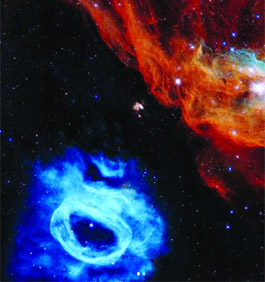
Space agency NASA routinely captures stunning images of our universe, leaving space lovers mesmerized. The Instagram handle of NASA is a treasure trove for those who love to watch educational videos and fascinating images showcasing Earth and space. On Monday, NASA shared two images captured by its Hubble telescope showing a ”cosmic reef’ 163,000 light-years from Earth in the constellation Dorado. NASA called it the ”cosmic reef” for its resemblance to a coral reef in Earth’s oceans.
Notably, the telescope captured two neighbouring clouds of cosmic dust and gas, the giant red nebula NGC 2014 and a smaller blue nebula nearby called NGC 2020. These nebulae are part of a vast star-forming region, the Large Magellanic Cloud, a satellite galaxy of the Milky Way full of massive stars.?
As per NASA, the stars near the center of the image are around 10 to 20 times the size of our Sun, and their intense radiation heats surrounding dense gases like oxygen seen in light blue to 20,000°F (11,000°C). The nebula in the lower left was created from a star 200,000 times brighter than our Sun, which ejected gas in a series of eruptive events.?
Describing the image, NASA wrote, ”An image is split in two. In the bottom left of the first image, a bright blue ring appears, slightly fading in all directions, with a small blue dot in the middle. Red and orange waves of gas ripple, arcing from top left to top right. A light blue center appears out of the sea of red, and several bright white dots shine through. In the top right, dark blue gas emanates from the blackness of space.?”
As per Space.com, the image was taken by Hubble’s Wide Field Camera 3 to mark the telescope’s 30 years in space.
Reacting to the image, one user wrote, ”Awesome capture. Colors are beautiful.” Another commented, ”That’s beautiful!!!” A third wrote, ”Ice & Fire.”
NASA’s Hubble Space Telescope, which was launched on April 24, 1990, has made more than 1.4 million observations of nearly 47,000 celestial objects. It was named after American astronomer Edwin P Hubble, who confirmed that our universe was constantly expanding. In its 30-year lifetime, the telescope has racked up more than 175,000 trips around our planet, totaling about 4.4 billion miles. Source: NDTV





Be the first to comment